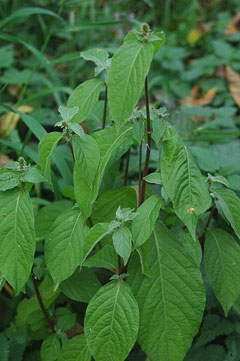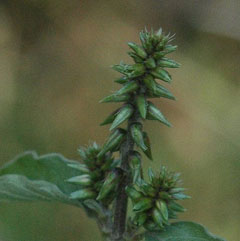 |
|
http://commons.wikimedia.org/wiki/User:Doronenko |
 |
| http://commons.wikimedia.org/wiki/User:Doronenko |
Translate this page:
Summary
Physical Characteristics

 Achyranthes bidentata is a PERENNIAL growing to 0.8 m (2ft 7in) by 0.4 m (1ft 4in).
Achyranthes bidentata is a PERENNIAL growing to 0.8 m (2ft 7in) by 0.4 m (1ft 4in).
See above for USDA hardiness. It is hardy to UK zone 8. It is in flower from August to September, and the seeds ripen from September to October. The species is hermaphrodite (has both male and female organs).
Suitable for: light (sandy) and medium (loamy) soils. Suitable pH: mildly acid and neutral soils. It can grow in semi-shade (light woodland) or no shade. It prefers moist soil.
UK Hardiness Map
US Hardiness Map
Synonyms
Plant Habitats
Cultivated Beds;
Edible Uses
Edible Parts: Leaves Seed
Edible Uses:
Seed - cooked. A good substitute for cereal grains in bread-making, they have often been used for this purpose in famine years[2, 177, 238]. The light brown oblong seed is about 1mm long[266]. Leaves - cooked[177, 178]. Used as a vegetable in the same manner as spinach[179].
References More on Edible Uses
Medicinal Uses
Plants For A Future can not take any responsibility for any adverse effects from the use of plants. Always seek advice from a professional before using a plant medicinally.
Anodyne Antiasthmatic Antiinflammatory Antirheumatic Bitter Digestive Diuretic Emmenagogue
Odontalgic Vasodilator
The roots, leaves and stems are widely used in Chinese herbal medicine[238]. The roots contain triterpenoid saponins, sitosterol and sigmasterol[283]. They are anodyne, antiinflammatory, antirheumatic, bitter, digestive, diuretic, emmenagogue and vasodilator[238, 283]. They act predominantly on the lower half of the body and are used in the treatment of aching back and knees and asthenia of the lower limbs[176, 238, 254]. Research suggests that they can cause dilation of the cervix and so this herb should not be used when pregnant[238]. The herb is taken internally to treat hypertension, back pains, urine in the blood, menstrual pain, bleeding etc[238, 283]. It lowers blood cholesterol levrels and so is used in the treatment of atherosclerosis[283]. The root juice is used in Nepal in the treatment of toothache[272]. This juice is also used in the treatment of indigestion and is considered to be a good treatment for asthma[272]. The stem of the plant is used as a toothbrush that is said to be good for the teeth and is also a treatment for pyorrhoea[272]. The plant can be used fresh or dried. The leaves and stems are harvested in the summer and are usually crushed for their juice or used in tinctures[238]. The roots are harvested from 1 or 2 year old plants in the autumn or winter and usually dried and ground into a powder or used in decoctions[238].
References More on Medicinal Uses
The Bookshop: Edible Plant Books
Our Latest books on Perennial Plants For Food Forests and Permaculture Gardens in paperback or digital formats.

Edible Tropical Plants
Food Forest Plants for Hotter Conditions: 250+ Plants For Tropical Food Forests & Permaculture Gardens.
More

Edible Temperate Plants
Plants for Your Food Forest: 500 Plants for Temperate Food Forests & Permaculture Gardens.
More

More Books
PFAF have eight books available in paperback and digital formats. Browse the shop for more information.
Shop Now
Other Uses
Insecticide Teeth
Two insect-moulting hormones are found in the roots[174]. Can this have a practical application as an insecticide? The stem of the plant is used as a toothbrush that is said to be good for the teeth and is also a treatment for pyorrhoea[272].
Special Uses
References More on Other Uses
Cultivation details
Prefers a rich, sandy, slightly acid soil in partial shade[238]. This species is probably not hardy in the colder areas of the country, it tolerates temperatures down to at least -5°c[238]. When grown in a rich soil the roots can be up to 1.2 metres long[238]. Widely cultivated in China, especially in Henan Province, as a medicinal plant[238] and as a food plant[179].
References Carbon Farming Information and Carbon Sequestration Information
Temperature Converter
Type a value in the Celsius field to convert the value to Fahrenheit:
Fahrenheit:
The PFAF Bookshop
Plants For A Future have a number of books available in paperback and digital form. Book titles include Edible Plants, Edible Perennials, Edible Trees,Edible Shrubs, Woodland Gardening, and Temperate Food Forest Plants. Our new book is Food Forest Plants For Hotter Conditions (Tropical and Sub-Tropical).
Shop Now
Plant Propagation
Seed - sow late spring in a greenhouse. Germination should be fairly rapid, prick out the seedlings into individual pots of fairly rich soil when they are large enough to handle. It is probably wise to grow this plant on in the greenhouse for its first winter, planting it out into its permanent position in late spring after the last expected frosts.
Other Names
If available other names are mentioned here
Native Range
TEMPERATE ASIA: Russian Federation (Primorye), China (Anhui Sheng, Zhejiang Sheng, Fujian Sheng, Hebei Sheng, Hunan Sheng, Hubei Sheng, Jiangsu Sheng, Guizhou Sheng, Shanxi Sheng, Shaanxi Sheng, Sichuan Sheng, Guangxi Zhuangzu Zizhiqu, Xizang Zizhiqu), Korea, Japan (Honshu, Kyushu, Shikoku), Taiwan TROPICAL ASIA: Bhutan, India, Sri Lanka, Nepal, Pakistan, Papua New Guinea, Solomon Islands, Laos, Myanmar, Thailand, Vietnam, Indonesia, Malaysia, Philippines AFRICA: Cameroon, Equatorial Guinea, Nigeria
Weed Potential
Right plant wrong place. We are currently updating this section.
Please note that a plant may be invasive in one area but may not in your area so it's worth checking.
Conservation Status
IUCN Red List of Threatened Plants Status :

Growth: S = slow M = medium F = fast. Soil: L = light (sandy) M = medium H = heavy (clay). pH: A = acid N = neutral B = basic (alkaline). Shade: F = full shade S = semi-shade N = no shade. Moisture: D = dry M = Moist We = wet Wa = water.
Now available:
Food Forest Plants for Mediterranean Conditions
350+ Perennial Plants For Mediterranean and Drier Food Forests and Permaculture Gardens.
[Paperback and eBook]
This is the third in Plants For A Future's series of plant guides for food forests tailored to
specific climate zones. Following volumes on temperate and tropical ecosystems, this book focuses
on species suited to Mediterranean conditions—regions with hot, dry summers and cool, wet winters,
often facing the added challenge of climate change.
Read More
Expert comment
Author
Blume.
Botanical References
74238266
Links / References
For a list of references used on this page please go here
Readers comment
| Add a comment |
|
If you have important information about this plant that may help other users please add a comment or link below. Only comments or links that are felt to be directly relevant to a plant will be included. If you think a comment/link or information contained on this page is inaccurate or misleading we would welcome your feedback at [email protected]. If you have questions about a plant please use the Forum on this website as we do not have the resources to answer questions ourselves.
* Please note: the comments by website users are not necessarily those held by PFAF and may give misleading or inaccurate information.
To leave a comment please Register or login here All comments need to be approved so will not appear immediately.
|
Subject : Achyranthes bidentata
|
|
|
|